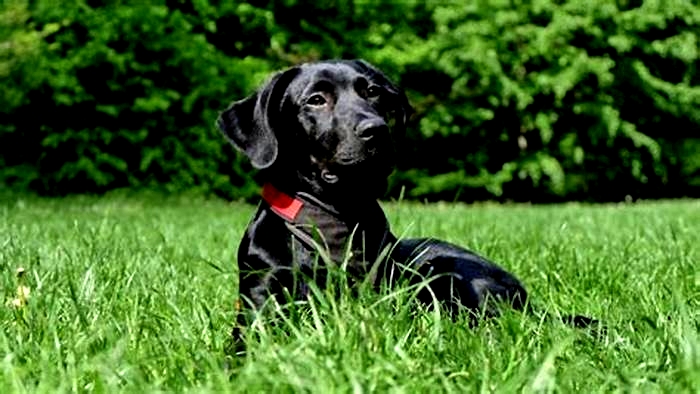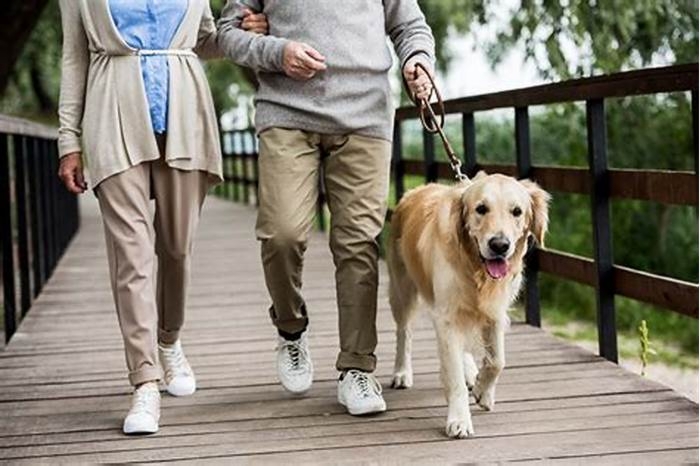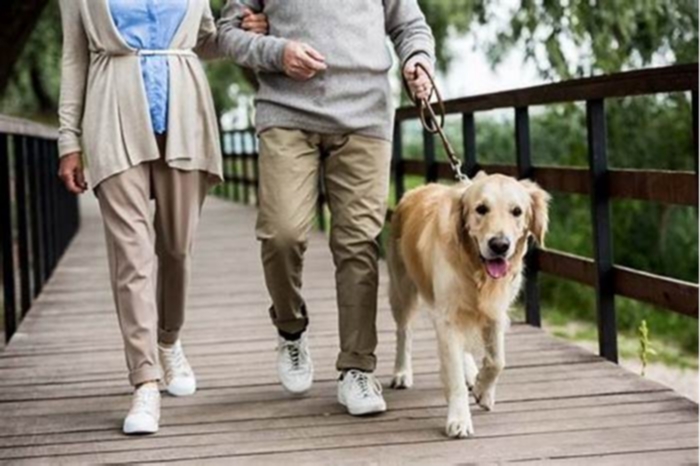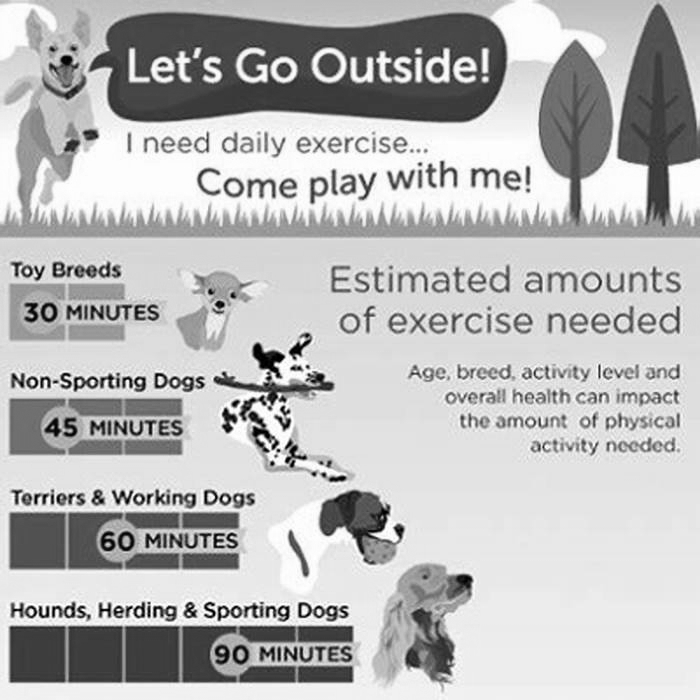Do Labradors like long walks

Labrador Walking Guide: How Many Times You Should Walk a Labrador?
Labradors are exceptionally energetic, and if their exercise needs arent managed correctly, you might end up with shredded curtains and a howling companion. You know you need to take your Labrador for a walk, but how many times per day should you do this?
You should walk a Labrador at least 1-3 times per day. Labs need at least 45-60 minutes of exercise and play daily, but they can often go longer if you allow it. You can combine walking, swimming, and games to increase how much your Labrador exercises throughout the day.
Labs can be great companions and often motivate you to exercise more. This article will discuss how often you should walk your Labrador, walking guidelines for each stage of your companions life, and if you can walk your Labrador too much. So stick around and get comfortable.
How Often Should You Walk Your Labrador?
Labradors were bred to retrieve things while hunting and working alongside their human companions. As such, theyre muscular and built to sustain hours of physical activity, meaning they should get as much exercise as you can give them.
Your Labrador should walk at least twice daily or more, spread out throughout the day, as this gives your pup a chance to rest and re-energize between walks. But you can also take them to a dog park and let them off the leash so they can run and play.
However, if its cold outside or your schedule is extremely busy, they can benefit from at least going outside for a few minutes 2-4 times a day before coming back inside.
How Long Should Each Walk Take?
Each walk should take at least 20-30 minutes; if it is laid back and slow-paced, it should take up to 90 minutes. However, Labs need a mixture of gentle walking and hard running to build their bones and muscles. They also need to build up their heart muscles, as we do.
You can take your dog to the park with a toy or a rope to meet this requirement and engage in some free play time.
Walking Alternatives for Your Labrador
Since Labradors are meant for hard work, you can set up a training course to work them out and train them to obey commands. The course should have your Lab running to fetch things that you throw. You can also have your dog retrieve something you hide after letting him smell it, or take him to a dog park and let him run around and socialize with other dogs.
In warmer months, take your Labrador swimming as a walking alternative. Elderly Labs, specifically, can benefit from this type of exercise, as its more gentle on their aging joints. And, if you enjoy swimming too, this is a perfect way to work in an alternative exercise.
If your backyard is big enough, throw a Frisbee around and have your Lab chase it for 10-15 minutes to expend your dogs pent-up energy.
Another activity you can do is play tug-of-war with your dog. Using a thick rope with a knot in the middle, engage your pup in pulling on it the opposite way you pull. Once in a while, however, its good to let him have it so that he feels a sense of accomplishment.
Caution: Dont let your dog bite you or nip you. He might be in play mode, but if he gets used to biting you, it could get serious quite quickly. So if he nips you or bites you, end the play time and go home.
Remember that if walking is all your Lab wants to do, then walking is perfectly acceptable. Yet, since your Lab wont be exercising very hard, youll want to extend your walk to at least 30 minutes and perhaps go for an hour.
Walking Guidelines for Each Stage of Life
Like humans, Labradors have different exercise requirements as they go through life stages. For example, puppies need more off-leash play time than adults, while senior Labs need to go at their pace and take frequent breaks.
However, adult Labs in their prime can go for long periods without rest. That doesnt mean they should, but they can. Before adopting a Labrador, familiarize yourself with how and when to walk him.
Puppy Walking Guide
Puppies arent fully developed and need more play than adult Labs. During this phase, you can train your puppy to walk on a leash, but hell be much happier if he can run around in a park, chasing a frisbee or a stick.
Also, since their legs and muscles are still developing, they shouldnt be required to walk for a set amount of time. Instead, they can play and run as much as they want. However, to keep them from tiring too quickly or getting injured, you can use the 5-minute rule.
This rule states that puppies should exercise 5 minutes for every month of age. So if your puppy is 5 months old, 25 minutes of daily exercise is sufficient. Let your puppy run in the park or backyard while playing games during this time.
However, if youre trying to leash-train your Labrador puppy, walking your puppy daily for a few minutes should be sufficient. Still, they must be off the leash during most of their exercise time.
Adult Walking Guide
Adult Labs are in the prime of their life and have the most energy. For this reason, they should get at least 45-60 minutes of exercise daily, if not more. You can take them running, walking, swimming, and playing several active games in the park or backyard.
Senior Walking Guide
As dogs age, their joints and muscles become sore, making walking difficult. You dont want to walk your senior Labrador very much, which could cause injury. If your Lab wants to walk, you can take him out for a gentle walk.
Yet youll want to monitor him to ensure hes not lagging behind or struggling to walk, which could indicate that hes in too much pain.
Old Labs, however, need more rest and less exercise. But if youre concerned that your Lab isnt getting enough exercise, swimming is a great way to help him get moving without too much shock to his joints. While you might think swimming is relaxing, it can be strenuous and intense, depending on how hard he swims.
Youll want to walk your senior Lab for at least 15 minutes daily. However, this isnt a hard and fast rule; youll want to go at your dogs pace. And remember, if you have any concerns about his physical health, make an appointment to see your vet for further diagnosis.
Can I Walk My Lab Too Much?
You can walk your lab too much, but it is unlikely, as a Labrador has more energy than you do. They would need to walk or run all day to release their pent-up energy. If youre too exhausted to walk or run with them, take them to a park and throw a ball or other toy around.
The exception to this is that you might need to limit your puppys walking, as they can walk too much. If your puppy is under 3 months old, you shouldnt walk him at all and, instead, let him play in short bursts. This is because their muscles and joints still need plenty of rest to develop properly.
Elderly Labs can also walk too much, as with humans, they can develop arthritis and other joint conditions that make it difficult and painful to walk. Making them walk more often than they can walk will cause injury.
Is It Okay Not To Walk a Labrador Daily?
It is okay not to walk a Labrador daily, but they get restless and can use their excess energy to destroy your home and belongings. While some experts claim that a Labs behavior can be modified with training, others say that a Lab needs exercise to stay calm.
Life can creep up on you, and before you know it, you have no time to walk your Labrador. It might start with one or two days every other week, but then it cascades to walking your Lab twice a week. While youre letting your dog out to relieve himself daily, he needs a lot more than that to stay fit and healthy and release pent-up energy.
But will he destroy your curtains and furniture if he doesnt get out for daily walks? Behavioral training is a large part of having a dog of any breed, regardless of whether they get enough exercise.
However, bored dogs with too much pent-up energy can get into more mischief than if they have an outlet for their energy.
If you dont have time for an hour-long walk with your Labrador once daily, try splitting your walks into 3 or 4 15-minute intervals throughout the day. This schedule will, at least, get your dog outside for some fresh air and exercise.
Regardless, walking your dog seems like a human invention, as most dogs prefer to run, play, and hunt. Walking is optional as long as your Lab gets enough exercise.
Winter Walking With Your Labrador
Most places in the world see at least some type of winter weather with snow, ice, and cold temperatures. And many locations can be downright hostile for humans and dogs alike.
What should you do during the winter months with your Labrador?
During most of the winter months, you can take your Lab out for walks if you dont stay out too long or go out when its frigid outside. However, he needs more exercise, so you might want to check out a canine fitness center, a growing trend in the dog world.
Essentially, its a gymnasium with doggie fitness equipment and training classes designed to work out your dog, much like a human fitness center. Plus, being indoors, you and your dog remain comfortable while exercising during the cold winter months.
Although, if your Lab likes the snow and cold, and you have a big backyard, you can let your dog outside to run in the snow for a while before coming back inside to warm up.
When You Should Take Walks With Your Lab
So you know how long walks should be with your Labrador, but is there any time during the day that is better for walks? No time is better than another time during the day to walk your dog, but youll want to keep your walks around the same time each day.
Labs and other dogs love routine and expect to go out on schedule. If youre walking your Lab at least twice daily, you could take him out in the morning and evening, which is the typical walking schedule.
Still, if your schedule is slightly different, you can adjust your Labs walking schedule, and as long as its consistent, it should be fine.
What About Naughty Behavior?
Labradors are one of the many breeds with a lot of energy and should get plenty of activity daily. But will your Lab destroy your furniture and other personal belongings if he doesnt get outside to exercise for one or two days?
Some people say yes, while others say no. But, they all agree that Labs that get a good amount of exercise tend to be better behaved and have fewer naughty episodes.
Conclusion
Labradors need at least an hour of exercise daily to be healthy and release their pent-up energy. This exercise can come from walks, running in the park, playing with other dogs, or playing with you.
Puppies can get most of their exercise from running and playing in your backyard or even in your house if its big enough. Senior Labs should tell you when they want to exercise, as you dont know if theyre in pain.
And remember, if you live where its cold most of the time, you can look for a doggie fitness center.

Can Labrador Retrievers Walk Long Distances? [Full Guide]
If you are a Lab owner, you may find yourself asking whether Labrador Retrievers walk long distances? Labs are full of energy, and exercise is important for keeping their heart, lungs, and joints healthy. It also helps them to maintain their ideal weight.
Labradors have the stamina, energy, and muscle strength to walk for long distances. Labradors have sound cardiovascular systems to handle long-distance walking. In fact, they need a lot of exercise.
As she got older and had a penchant for overeating, the walks helped her maintain a healthy weight. This also helped to ease the pressure off of her joints. To make those long distances comfortable, you would need to consider factors such as age, ailments, and overall well-being.
In this article, you will learn about the benefits that long walks can have on your dog. You will also learn how long Labs can go on their walks and what you will need to do to make the walks comfortable. In the end, you will know the best way to use walks to give your Lab the required exercise so that you will have a happy and healthy activity that you both enjoy.
Why Should You Listen To Me?
As a Lab owner for 14 years, I know how important it is that your Lab gets the right amount of exercise for their health and the happiness in your home.
When we would get lax with her walks, our Lab Bear would often get rambunctious.
When she would get overactive, a nice long walk would appease her and help calm her down.

Can Labrador Retrievers Walk Long Distances?
Labs were bred for hard work. They are descended from breeds that were once used for the water rescue of fishermen. Their breed has a significant amount of muscle strength. This allows them to pull rescue victims sometimes more than twice their weight from the water. This muscle strength can help them to have greater endurance when it comes to long periods of exercise.
But that is not all.
Labs were bred to not only be good swimmers but also divers. Thus, they have a large lung capacity, which increases their stamina. It also prevents them from fatiguing when exercising for long periods.
Their lighter weight and muscular body makes them quick on their feet. This allows them to walk long distances without excess weight slowing them down.
Walking is a great way to get exercise with your Lab without worrying about the overexertion that can come with swimming or running.
Since walking is a more moderate exercise and it is easier to monitor your Lab, longer distances can be easily and safely achieved.
Whats the Definition of a Long-Distance Walk?
When deciding whether long-distance walks will work for you and your dog, you will first need to understand what qualifies as a long-distance walk.
Generally speaking, a long-distance walk will be a walk for at least 10 miles or more, but usually is less than 20 miles.
Whichever distance you choose, it will be important to maintain a more even pace so that you and your Lab does not tire from starting out too fast too early.
If you plan to go a long distance, you will not want to attempt to speed walk. Save this for shorter distances when you are trying to get your heart rate up for a short duration of time. Instead, try to get up to a pace between a saunter and a speed walk. Your heart rate should be slightly elevated and breathing a little quicker, but you should not be breathing rapidly, nor should your dog.
Why is the Labrador Retriever Suitable to Walk Long Distances?
Labrador Retrievers are working dogs, which means that they need to be active and working out their muscles throughout much of the day.
Added to that is the fact that Labs are quite energetic and physically designed to undergo a lot of physical activity.
Their bodies are mostly lean muscle, which makes them more agile and able to manage long bouts of physical activity.
They also have a good lung capacity and a cardiovascular system that does not overexert as easily as you may find with smaller breeds.
On top of that, Labs have a double coat of short fur. This allows them to be outside in various temperatures as their body is better insulated, and they do not have heavy hair to weigh them down.
What Conditions/Physical Characteristics Need to be Met to Walk Long Distances?
Most Labs are capable of walking long distances without any problems. But there are things to consider to determine if your Labrador is in the physical condition needed.
Weight
One of the first things to consider is your dogs weight.
Your Lab mustnt be too thin or overweight before starting them on longer walks.
If your dog is underweight, they may not have the muscle strength for the long distance, and it may actually hinder their health.
60% of Labradors in the US are overweight. For overweight dogs, too long walks can put more strain on their cardiovascular system and joints. For an overweight dog, exercise is essential, but you should start off with shorter distances until they get to a healthy weight.
You can view the video below for the risks facing an overweight dog and how a dog can lose weight.
An overweight Labrador would typically weigh more than 85 pounds or 30 kilograms.
Energy level
You will also want to consider your Labs energy level.
While most Labs are high energy throughout their life, some may be more laid back and not as active.
It is important they get a decent amount of exercise during the day. But for dogs with less energy, shorter durations of exercise more often would be recommended.
How to Train Your Lab to Walk Long Distances
Since long-distance walking requires endurance, you will need to train your dog to handle extended periods of exercise.
Training your dog for long-distance walks involves combining the proper endurance, drills, and behavioral training to ensure they are prepared.
Step 1 Diet
Ensure that your Lab has a healthy diet that can build lean muscle and provide them with the energy they need to go the distance.
Their diet should be high in protein and fat but low in carbohydrates.
Ensure they are eating the appropriate amount of food throughout the day and intake plenty of water to stay hydrated.
Step 2 Control their behavior
Next, you will want to get control of their behavior.
They should be trained to walk well on a leash and be able to keep an even pace. This means walking with a loose leash while beside you.
A dog that continually pulls will overexert themselves quickly and is not yet ready to embark on distance walks.
If your Lab is not good on the leash, start small by taking them on short walks, making sure that they stay beside you, and listen to your verbal commands.
When they do well, be sure to reward them with a treat to reinforce the behavior.
For Labs that are aggressive pullers, you may need to use a head halter until the habit is broken. Before you go down that route, try this leash respect technique taught by dog trainers, McCann Dog Training.
Never use a retractable leash when walking your dog, as the ability to move freely or be pulled back quickly may encourage them to pull more.
Step 3 Responding to other verbal commands
Your dog should also be well-trained enough to follow your verbal commands, such as heel, stop, and stay.
During a long walk, you will need to maintain control over your Lab at all times for your safety and theirs.
Step 4 Endurance training
Once your Lab is correctly trained with good walking behaviors, It is time to move on to endurance training.
Determine the distance that you would like to achieve for your long walks.
Start by doing that same distance over five days. You can then slowly decrease the days while keeping the same distance until your Lab is ready to complete it all in one day.
Step 5 Supplement with short walks
While doing these shorter walks, you can also work on their muscle development by having them perform short sprinting activities.
This will give their muscles a good workout and recovery period, allowing them to keep their muscles in shape.
A fun activity for sprinting is frisbee catching.
During your training regime, be sure to have your dog stretch, just as you would. You can help stretch and massage their muscles or mimick stretching movements for them to do. There is a good chance they may want to join in.
How Often Should You Do Long Distance Walking?
If your dog is fit enough for long-distance walking, the walks frequency will be up to their individual endurance levels.
When getting started, you should limit long-distance walking to once a month. But if your dog does well with it and seems to still have energy even after the long walking session, then you may be able to up their frequency.
Once they have built up their endurance, you should limit these long walks to once a week to give your dog time for their body to recover and recharge.
The Benefits of Walking: Short vs. Long Distances
Walking your dog can be beneficial not only for your health but for your Labs as well.
One of the most significant benefits of walking your Lab is that it can help keep them at a healthy weight and maintain their muscle strength.
When your Lab is fit, they will enjoy better respiratory and cardiovascular health, leading to improved longevity.
Exercise and weight control can also improve your Labs joint health, which is a common ailment that Labs can face as they get older.
On top of all the physical benefits, walking your Lab can provide them with mental benefits as well.
It can help them get out excess energy, socialize, and enjoy new sights, sounds, and smells. In short, walking will make your dog happier.
While both long and short-distance walking share the benefits weve covered, long-distance walking provides added benefits:
- Allows them to get a lot of their excess energy out so that they can get better rest and sleep;
- Enables them to improve their lung capacity as they build up their stamina; and
- Provides them with added muscle strength, which will help them to better burn fat and keep a healthier weight.
Labs That Should Not Walk Long Distances
As mentioned above, while most Labs can walk long distances, some Labs should not.
Certain conditions and age can play a factor as to whether or not walking for long distances would be considered safe.
Below are the Labs that should avoid walking for long distances.
Puppies
While puppies have endless energy, they have yet to develop the physical strength and maturity in their respiratory and cardiovascular systems to handle longer distances. On top of that, they are still learning commands and how to walk on a leash properly.
Elderly
Once your Lab is an advanced age, their walks should be limited to shorter distances. Elderly Labs will have more wear on their joints, becoming more damaged by walking long distances. They also will not have as good of endurance as they used to and will be more prone to overexertion.
Recovering from an operation
If your Lab has had an operation or procedure, you should wait a few months after your dog has healed to try to walk for long distances. After they recover, they will need to rebuild stamina and muscle strength before you consider extended walks.
Overweight Labs
Labs that are overweight already have stress on their heart and their lungs. Adding too much exertion can lead to possible complications resulting from this stress. Walking a Lab for long distances when they are too heavy can also put too much strain on their joints, causing them to wear down quicker than they should.
What To Look Out For When Walking Labs Long Distances
Once you begin your Lab on long-distance walks, you will need to be aware of the signs and symptoms that they could be in distress and need a break.
Being vigilant about these signs can prevent your pet from experiencing a major medical complication.
Some things to watch for on your walks include.
Overtired
Your dog may be overtired if they begin laying down during the walk. Also if they keep stopping to sniff the ground, are panting more than usual, or seem to not be listening to your commands. If you see this, stop and let your dog rest before returning home.
Heat exhaustion
Your dog may be suffering from heat exhaustion if they become confused, vomit, collapse, excessive panting, or have an increased heart rate.
You can prevent heat exhaustion by making sure your dog is well hydrated, walking on cooler days, and making sure there is shade on your walk route.
Dehydration
If your dog begins to look lethargic, their eyes or nose are dry, or their gums are sticky, it could be a sign that they are dehydrated.
Always make sure to take plenty of water on your walks and make stops for hydration.
Exercise-induced collapse in Labs
This is a genetic condition that some Labs may have.
When at rest, they will seem normal and as fit as a Lab without the condition. But once they have done more than 10 minutes of strenuous activity, they may become weak or collapse.
If you notice signs of this condition in your dog, you will have to develop a modified exercise routine.
The Best Gear For Walking Your Labrador
Best dog collars for Labradors
Given the Labradors size and strength, you need something well made, strong, highly rated, and durable so that it lasts.
We recommended the Signature Canine collar.
Its made in America by Amish artisans in Pennsylvania from leather that is double layered for extra strength.
The quality of the Signature collar is considered fit for use in law enforcement and military purposes.
You can purchase the Signature collar here, and theres a matching leash too.
Dog leashes
If you walk that long-distance, not inside a National Park, Id recommend a simple standard leash thats strong enough for your Lab. These leashes can range between 4-6 feet long.
If you are going for those long walks inside a National Park, regulations stipulate you need to have your Lab on a 6 feet long leash. For longer length leashes, you can buy adjustable dog leashes.
Best harness for a Labrador
| Brand | Model | Key benefit |
| Kurgo | Journey | Best option for hiking; back handle to grab your Lab when you need to |
| Julius | K9 Powerharness | Heavy duty |
| Frisco | Padded front lead dog harness | Dual clip (extra strong); slip on design |
| Ruffwear | Front Range | Padded for extra comfort; 2 leash points front and chest. |
Best options for labs that pull
There are a couple of options for Labs that pull hard on a leash and are challenging to control:
A no-pull harness goes across the chest and clips on the dog leash at the front.
This is a harness for your Labs head. The idea behind it is that your Lab cant put as much force behind their head as they can with a standard harness that sits against their chest. The halter loops over your Labs muzzle, shown in the photo below.

If you are walking long distances, I would recommend a no-pull harness over a head halter for comfort. But if your Lab is a terrible puller, then for your own convenience, go with a head halter.
Here are the best options I recommend when walking long distances with a Lab that pulls.
And what long-distance walk wouldnt be complete without a collapsible water bowl. Our recommendation is the Prima Pets dog bowl, which can clip on the dog leash.
Related Questions
Are Labradors good off-leash?
Bred as retrievers, Labs spent much of their time off-leash returning shot game to their hunter-owners. Labs will be good off-leash when they are well trained. As they are an intelligent breed of dog, they can be easily trained in recall commands.
Even the best-trained dog will have triggers that can cause them to give chase, such as seeing a rabbit or another dog. This can be dangerous, especially when on busy roads or when they approach another dog that may not be friendly.
If you want to let your Lab enjoy some time off of the leash, keep them leashed on roads and more populated areas. Then let them off when you are on wooded paths, parks, or along a beach.
If you plan on having your dog off the leash at any time, be sure you know the leash laws of the area you are walking in to make sure that it is allowed.
Conclusion
Long-distance walking is an excellent way for high-energy dogs to get their exercise and bond with their owners. As long as they are healthy and fit, a Lab should have no problems walking for distances of even 10 or 20 miles. Good endurance and behavioral training, along with a good diet, can help to prepare your Lab to make these long walks successful. Once you have your dog trained for distance walking, you will be able to explore together and build an even stronger bond.









